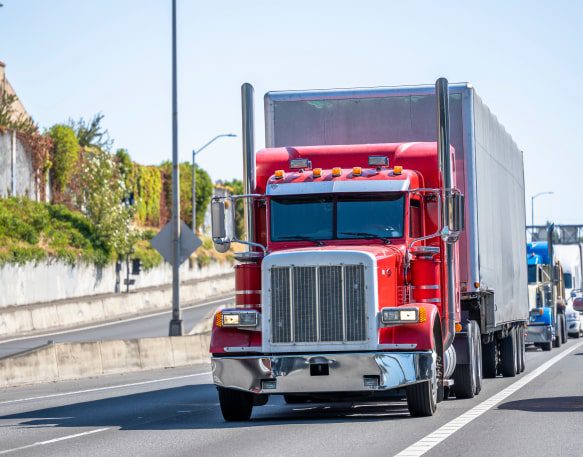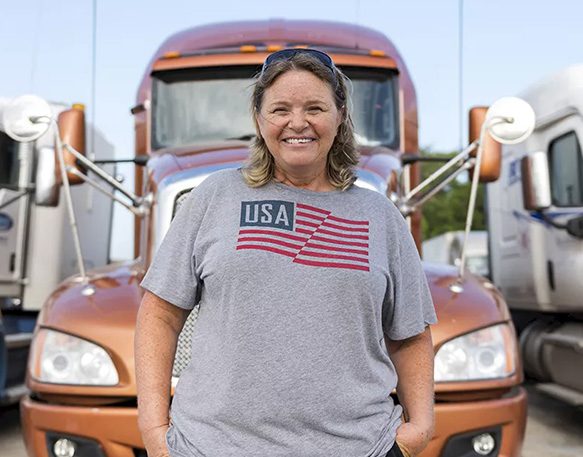As an owner-operator, one of your top priorities is finding the right freight. However, finding loads can be difficult if you don’t have the right strategy.
Being an owner-operator is a lot of work. Not only will you need to handle the paperwork of starting and running a business and lease or purchase a vehicle on your own, but you’ll also have to handle your finances and maintain your truck consistently. On top of all that, you’ll need to find loads if you’re an independent owner-operator.
If you want to be one of the best owner-operator companies on the road, you’ll need the right strategy for finding freight. After all, if you don’t move fast enough or don’t make strategic decisions when it comes to loads, you’ll quickly fall behind the competition. On the other hand, if you consistently find truck loads for owner-operators and make profitable trips, you can rise and become one of the best owner-operator companies out there.
What is an owner-operator?
While many truck drivers operate vehicles owned by their carrier employer, owner-operators own or lease their truck and other equipment. May owner-operators lease on with a carrier, essentially working as contractors who operate under the carrier’s MC number. This arrangement gives owner-operators more flexibility than company drivers. They’re often responsible for their own expenses, but have the benefit of the carrier providing them with loads.
Leasing on with a carrier increases an owner-operator’s earning potential when compared to a company driver, but they’re still sharing profits with the carrier. For completely independent owner-operators, they operate as their own carrier under their own MC number. They’re responsible for finding their own loads and everything else that comes with running a trucking business. While they’ll have a higher earning potential than their leased-on counterparts, independent owner-operators will assume more risk and must take on more responsibilities.
No matter what kind of owner-operator you want to be, there are a few things all owner-operators need to do before hauling their first load.
How to become an owner-operator
While there are certainly perks to becoming an owner-operator, it also requires a lot of upfront work if you want to succeed. Not only do you need to have the appropriate permits and licenses in place before you can hit the road, but you also need to have a solid business plan. After all, you want to be ready to hit the ground running with a plan for success. To become an owner-operator, you’ll need to:
Gain some driving experience
If you’ve never driven a truck before, being an owner-operator might not be the right step for you right now. Many owner-operators start as company drivers to get experience without all the financial risk that comes with being your own boss. Plus, being a commercial driver will allow you to discover if you like over-the-road (OTR) trucking or prefer shorter trips before you sink time and money into your business only to discover you might not actually enjoy the type of driving you signed up for.
You’ll likely need a commercial driver’s license (CDL). The good news is that it’s not particularly difficult to earn your CDL. You’ll just need to pass a physical exam, study your state’s CDL handbook (or take a class), and pass a knowledge test. Then, you can earn your CDL permit and take the CDL skills test to receive your full license and start driving commercial trucks.
Form a business
If you decide to become an owner-operator, you’ll need to form a legitimate business. Visit your state’s Secretary of State’s website to determine if your intended business name is available. Then decide on a business structure (options include a limited liability company (LLC), sole proprietorship, partnership, or corporation). Finally, complete the application, pay your registration fee, and submit your paperwork.
Obtain your operating authority
Once you’ve formed your business, you may decide to go independent. If so, you’ll need to get your owner-operator authority. To do this, you’ll need the following:
- Your USDOT number: You can apply for your U.S. Department of Transportation (USDOT) number through the Federal Motor Carrier Safety Administration (FMCSA). This will identify you as a carrier conducting interstate commerce.
- Your MC number: Obtaining an MC number, or a motor carrier number, is another essential part of getting your owner-operating authority and transporting freight for hire. You can also apply for this through the FMCSA’s website.
- Federal and state permits: In addition to your USDOT and MC numbers, you’ll need federal and state permits to start working as an owner-operator.
- Process agents: To become an owner-operator, you’ll also need designated process agents in every state you operate in. These professionals can send and receive legal documents on your behalf. Once you have process agents, they can file your Form BOC-3 with the FMCSA.
Purchase insurance
All owner-operators need to have at least $750,000 in liability coverage. However, most shippers and brokers require at least $1 million in coverage. Also, consider purchasing cargo insurance, roadside breakdown coverage, personal property insurance, bobtail insurance, and more. Even if you don’t purchase these other forms of insurance in advance, keep their costs in mind when creating your business plan and thinking through your finances.
Develop a business plan
You’ll want to have a solid, detailed business plan before you get started. Make sure to include an executive summary, company overview, marketing plan, and financial plan. Also include your business goals and a list of staff (if relevant). Doing the work now will come in handy later and it will even help you secure external financing if you need it to start your business.
How to find loads as an owner-operator
Once you have all your paperwork filed and licenses on hand, it’s time to find loads! While searching for the best truck loads for owner-operators can easily consume hours of your valuable time, it doesn’t have to. As long as you use the right load-finding methods and invest in the best possible tools, finding profitable loads will be a breeze!
Some of the best ways to find truck loads for owner-operators are:
Working with a freight broker
Freight brokers serve as intermediaries between owner-operators and shippers, so they have tons of experience connecting drivers to the right loads. The best freight brokers for owner-operators know all the ins and outs of the industry and will save you plenty of time and energy, so you can focus on providing customers with the best possible service.
Whether you want a load at a certain time, headed to a specific destination, or above a certain price, the best freight brokers for owner-operators can tap into their network of shippers to find something that meets your criteria. They can even negotiate on your behalf to get the best possible price! Of course, they won’t do this for free. You’ll likely have to pay your freight broker 15-25% of the load’s total profit in return for their service, but that’s a fair price for the best freight brokers for owner-operators.
Using a freight dispatcher
It’s also possible to use a freight dispatcher to find loads for owner-operators. Whether you opt for a personal dispatcher or a dispatching service, they’ll be able to connect you with shippers that are willing to work with new owner-operators. Dispatchers can also help with your paperwork, accounting, and trip management. Some will even track your mileage, repairs, fuel usage, and other expenses, so you can concentrate on hauling freight and other essential business tasks.
However, just like the best freight brokers for owner-operators, dispatchers will take a cut of the profit. While every dispatcher is different, most will either charge a flat rate per load or take 5-10% off of every load.
Working directly with a shipper
If you don’t want to go through a dispatcher or hire the best freight brokers for owner-operators, you can always work with shippers directly. This way you won’t have to pass on some of your hard-earned profits to someone else. Working directly with a shipper will require more time and effort, but can be worth it in the end.
Of course, you’ll need to establish connections with shippers before you start hauling loads for them, which could mean lots and lots of cold calling. You’ll need to find shippers’ contact information, reach out to introduce yourself, and discuss whether they require a carrier. You’ll likely face countless rejections, but you may also find shippers ready and willing to hire a new carrier. By fulfilling your commitments and proving you’re a reliable carrier, you can form a strong relationship that leads to a long-term partnership. So, whenever a shipper needs a load delivered, they’ll think of you and give you a call.
Another great option to find shippers is to start proactively networking. Consider joining industry associations to increase your visibility and form valuable connections, which could lead to business opportunities in the future.
Becoming a government contractor
Governments are just like shippers in that they also have transportation needs. So, if you don’t feel like reaching out to shippers, you can always see if any local, state, or federal government agencies have open contracts.
To become a government contractor, you’ll first need to register on the U.S. General Services Administration’s website. You’ll then be able to find loads and potentially win bids, resulting in steady work and decent pay. Government contractor positions are typically fairly competitive, so you may not be able to gain a position when you first start out, but if you persist, these contracts can prove a great source of consistent work!
Expanding cargo specializations and contract types
If you can’t find any loads and want to keep profits high, you can always try expanding your cargo specializations to broaden your horizons. For example, you might purchase a reefer truck to open the doors to reefer transport in addition to other types of freight that don’t require refrigeration. You might also diversify your offerings and get certified to provide hazardous load transport.
You might also consider taking on various contract types to increase opportunities to pick up truck loads for owner-operators. While having long-term contracts makes life much easier and less stressful for owner-operators, securing these contracts isn’t always easy. If you can’t find any long-term trucking contracts, don’t be afraid to accept spot loads or short-term contracts of three to six months.
Taking advantage of a load board
While there are plenty of ways for owner-operators to find loads, we think load boards are the best place to hunt for freight. After all, you can find loads in minutes, and all you need is a device and access to the internet. It’s much faster and simpler than cold calling shippers, working with the best freight brokers for owner-operators, or painstakingly networking with shippers at events. You’ll save time, energy, and money when you use a load board and can spend more time delivering cargo and less time in the office working out the logistics. This will help you get your business off the ground even faster.
A typical load board will show you what type of cargo needs to be shipped, how much it weighs, where it’s currently located, and where you’ll need to take it. You can often accept a load through the load board with a few taps and start hauling shortly after.
However, not all load boards are created equal. Some are highly specialized or localized, which could mean needing to consult several load boards before you can find the perfect freight. Some display the available loads, while others provide additional information about the shipper, such as their credit rating or average time-to-pay. Some only have extremely low-pay jobs, while others are negotiable. The best load boards for owner-operators can help you reduce deadheading, keep your trucks on the road, maximize fuel usage, and raise your profits. If you’re looking to find the best loads for owner-operators, you need to use the best load board on the market: the DAT load board.
Find owner-operator loads with DAT
If you’re looking for one of the best load boards for owner-operators, look no further. The DAT load board is a one-stop shop for owner-operators looking to find the best freight to keep their business moving. With over 267 million trucks and loads posted each year, the DAT load board has more freight than any other load boards for owner-operators. While it might seem daunting to have so many loads at your fingertips, you won’t be overwhelmed thanks to DAT’s easy-to-use filtering capabilities that make finding the perfect freight that matches your needs a piece of cake.
With the DAT load board on your side, you can easily find the best paying freight for owner-operators and become one of the top owner-operator companies. After all, the DAT load board has owner-operator cargo van loads, flatbed loads for owner-operators, and much more. You can even post your truck and let the shippers come to you! So, no matter what type of load you’re looking for, you’ll be able to find it on the DAT load board and stay productive and profitable throughout the year.
DAT has several load board subscription plans, so you can find one that suits your business needs. Whether you opt for the TruckersEdge Standard, TruckersEdge Enhanced, TruckersEdge Professional, Power Select Carrier, or Power Office Carrier plan, the DAT load board can help you find where your trucks are needed so you can efficiently grow your business.
With DAT, you’ll gain access to the best freight brokers for owner-operators and the best shippers. And you won’t just get their contact information. You can also view their credit history, average time to pay, and reviews from other carriers and owner-operators to determine who you want to work with. You can even see the latest market trends and average rates, which will make picking strategic loads or negotiating rates much easier. Some plans also offer market maps that tell you where demand is highest and Tri-Haul, a feature that delivers automatic triangle hauling suggestions. This way, you know exactly where to find the most profitable loads.
Ready to find the best loads available and be well on your way to becoming one of the best owner-operator companies? Sign up for the DAT load board today!
Start finding loads for owner-operators today with DAT!
The best way to find loads for owner-operators is with a subscription to the biggest and best load board in the industry: the DAT load board. With more than 644,500 new posts every business day, there’s always something new to discover on DAT. Get started today!




